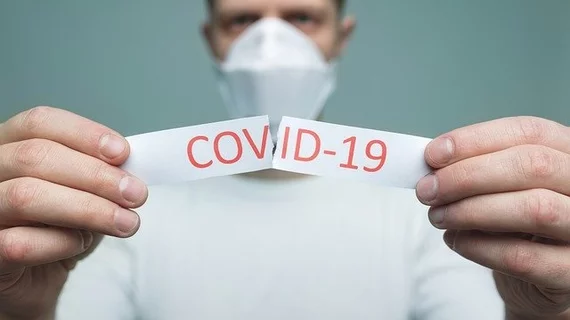Returning to Play: The Evolution of Cardiac Guidelines for Athletes with COVID-19

Our understanding of COVID-19 has evolved greatly since its first appearance in the U.S. in early 2020. Though our knowledge remains incomplete, we’ve learned a lot about the pathophysiology of the virus—especially its unique effects on the heart.
An interesting group to study has been athletes. Elite endurance athletes in particular often have exercise-induced changes to the heart to begin with. Differentiating these normal adaptations from the pathology caused by COVID-19 can be challenging. Myocarditis, one of the ways COVID-19 can injure the heart, has important implications for athletes where exercising during the acute phase of the disease can potentially exacerbate damage to the heart and even result in sudden death.
Advising athletes when it’s safe to return to play (RTP) has also been an important question, and one that’s beginning to have a clearer answer.
Evolving toward algorithms
In May 2020, my colleagues and I published guidance for sports medicine, family doctors and cardiologists to help them decide when athletes should be tested and which tests should be done on preliminary evaluation (JAMA Cardiol 2020;5[10]:1085-66). Existing data tended to be on hospitalized and often older people with an array of existing heart problems; not surprisingly, heart issues from COVID-19 also were common.
At that time, we recommended a fairly conservative strategy for athletes, whereby if an athlete tested positive for COVID-19 and was symptomatic, he or she should undergo fairly rigorous testing and evaluation before being allowed to return to play. We recognized that the recommendations might change as additional data came in, and so they did.
We published an update in October (JAMA Cardiol, online October 26, 2020). As we anticipated, we have come to understand that a more nuanced approach is warranted when determining safe RTP. Accumulating experience tells us that athletes who have mild symptoms during the infection or are asymptomatic rarely run into problems from a cardiac perspective. So, cardiac testing for these individuals is low yield and unlikely to be necessary.
The update includes algorithms that can be used to determine an appropriate course of action for various groups of athletes: high-school athletes both below and above age 15, professional and competitive adult athletes, and masters-level recreational athletes. The algorithms illustrate the steps that should be taken under different circumstances; what testing is recommended, depending on symptom severity and other variables; and who can be cleared to play.
We have emphasized a gradual RTP along with close monitoring for cardiovascular symptoms as the athlete becomes more active. If an individual complains of shortness of breath, chest pain, palpitations, a sensation of the heart racing in the chest or fainting/near-fainting episodes, then he or she should be evaluated by a sports or local cardiologist. Some testing will likely be required at that point, even if the individual initially had mild disease. Professional sports leagues and college sports teams also need to understand the process and know how to respond to athletes who present with COVID-19.
Recognizing the COVID-19 heart
As a corollary, we also published an expert consensus document looking at a critical distinction: the healthy, normal athlete’s heart vs. the heart that has been adversely affected by COVID-19 (JACC Cardiovasc Imaging 2020;13[12]:2635-52).
A long-observed and fascinating distinction in the athlete’s heart is the natural changes to the myocardium that can sometimes mimic myocarditis. But this exercise-induced cardiac remodeling is not pathological—it is a normal adaptive state commonly observed in athletes.
But with COVID-19 in the mix, it can be hard to tell the difference between a normal athlete’s heart and the ill effects of COVID-19, which is known to cause cardiopulmonary complications. Because this has been a topic of concern for cardiologists treating athletes with COVID-19, the expert consensus document helps distinguish changes that are likely related to athlete’s heart and do not require further testing and those likely to be associated with COVID-19. My colleagues and I describe the telltale signs and “red flags” that should be on the cardiologists’ radar and may warrant further testing.
Understanding imaging options & controversies
We also offer a stepwise approach regarding what the next test should be under various conditions. In particular, we outline the benefits and pitfalls of using various imaging modalities: echocardiography, cardiac magnetic resonance (CMR) imaging, coronary computed tomography angiography, exercise testing and nuclear testing including PET.
Recently, there has been controversy about the utility of CMR and the clinical implications of subtle abnormal findings in the context of a minimally symptomatic or asymptomatic individual. Decisions regarding starting or canceling major sporting events have been proposed to hinge on such reports. We provide a critical review of the available data and make recommendations for using CMR for athletes after COVID-19.
The guidelines for athletes with COVID-19 are evolving and may change yet. An important addition will be to review large registry data of cardiac testing and outcomes in athletes after COVID-19. Looking at these data from many thousands of athletes—across different ages and genders, sporting disciplines, presentation of symptoms and severities of disease—will be the best way to fully understand COVID-19’s effects on the heart over time. We soon will have data from professional organizations, including the NBA, WNBA, NFL, NHL, MLS and college sports organizations. Synthesizing these new numbers as they come in and obtaining outcome data will allow us to finetune our recommendations and provide more nuanced guidelines for athletes and their doctors.
Dermot Phelan, MD, PhD, is the medical director of cardiovascular imaging, director of sports cardiology and co-director of the hypertrophic cardiomyopathy center at Atrium Health Sanger Heart & Vascular Institute in Charlotte, NC.
